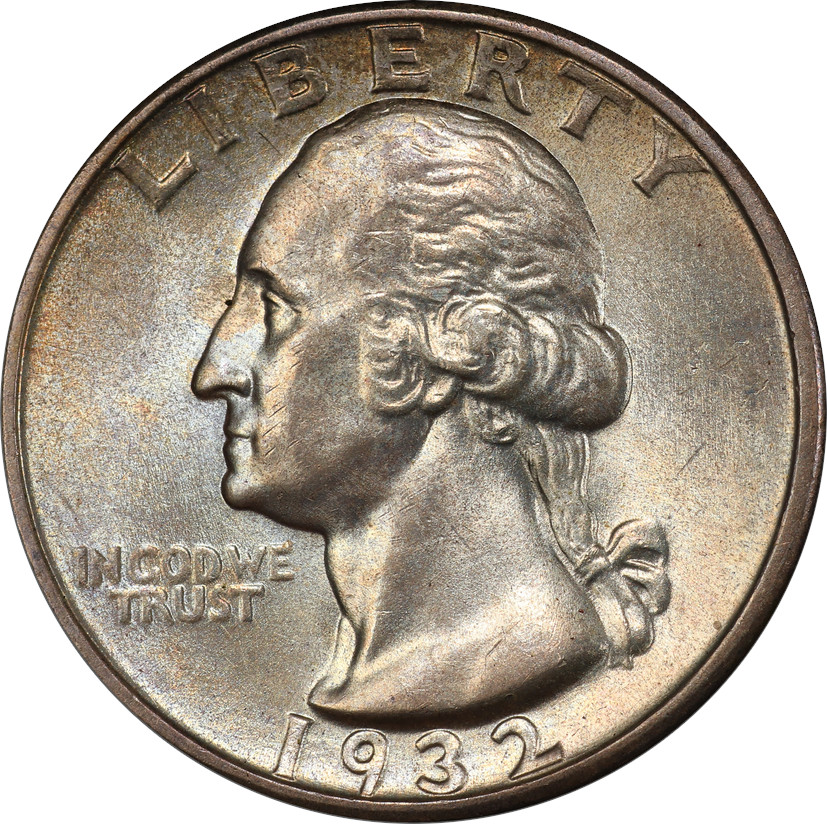This article seemed like a fun, straightforward task – let’s have a look at Mint State 64 Key Date Washington Quarters. This is a heavily collected grade, and it seems like it’s a great coin that people will enjoy reading about.

A rather nice example of key date Washington Quarter ’32-D in Mint State 64. A few light dings mar the obverse, but overall eye appeal is good.

A rather nice example of key date Washington Quarter ’32-D in Mint State 64. This piece is better struck than some, with detail through much of the eagle’s breast.
As it turns out, they’re not so straightforward. They’re all over the place. It turns out that not all 4s are created alike (shocker, I know – but!). And that’s how it’s been for quite some time. A lot of people seem to play the crack-out game with them. 4s have degraded over time, 4+s are pretty nice looking, and of course the jump to 5 is pretty substantial.
And this isn’t a new phenomena. ’32-Ds have ranged from 2 to 6k in the past 10 – 15 years. Currently, they’ve slumped a bit, down under 2k. They seem to be hovering between $1,200 and $1,800 at time of writing, though CAC and + coins seem to bottom out at $1,500 and + CACs have recently gotten close to $4k.
That’s a pretty wide range.
It mostly comes down to eye appeal. The better the strike, the better the luster, the fewer the big marks, the better the coins do. Light grazings overall, especially light in the fields, are more popular with collectors than coins with few significant hits. Frosty coins seem to carry more of a premium than sharp luster pieces.
There are not a lot of toned coins out there. Back when everyone was playing crack-out, brilliant coins were more popular, so deeply, originally toned coins were dipped out. There are still a few out there, but not as many as in other series. The really good doctors have kept their hands off of 64s for now.
Unfortunately, that means there are no flaws hidden. As is always the case, inspect the coins in person. Don’t trust photos.
As these are four-figure coins, NGC and PCGS are the most liquid. NGC coins seem to carry a slight premium over PCGS coins, in the case of 1932-Ds.
Again, CAC coins and Plus Coins always do well, and they always carry a substantial premium.
It’s hard to say what the future holds for 4 coins. As is always the case, buy the top coins, not the best you can afford. Carefully examine for eye appeal, and get the best you can. In the end, make sure you’re happy with the piece you choose, and that you love it. You might have to hold it for a while to get your money out of it. Hopefully, we’re at the nadir of this bear cycle for coins like this.
Concerning PCGS, there are only 2 pieces in 6, and a handful in 5+. By the time you get down to 4, there are plenty of 1932-Ds to go around.
There’s only one NGC-6, but more 5s. So if you’re interested in a Washington Quarter for investment, the way that has worked until now is to get one of those 5+s or 6s. Unfortunately for now, a 6 will cost you 6 figures, and a 5 will be somewhere around $20 – 30k.
The next generation seems interested in Washingtons, so the future may be bright for silver, classic Washingtons. But of course, without a crystal ball, there is no way to know.
Just get yourself a beautiful coin you love and don’t worry about it. Plan to hold it for some time, and keep an eye on the market from time to time when it comes time to sell.
Other than that, happy collecting!
